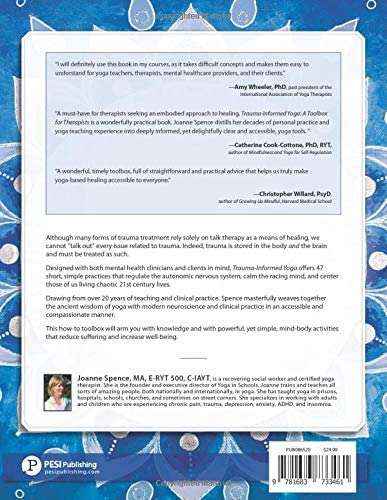Joanne Spence is the ideal person to write this book. She has healed her own body using the yoga practices she provides in this book for therapists. She tells her own story of healing and helping others along with her discovery of the scientific reasons why this therapy works. The second half of the book devoted to the practices for therapists to use with their clients is easy enough to follow even if you are not a professional yogi. I am an amateur at yoga and not a therapist, and I am able to
Joanne Spence is the ideal person to write this book. She has healed her own body using the yoga practices she provides in this book for therapists. She tells her own story of healing and helping others along with her discovery of the scientific reasons why this therapy works. The second half of the book devoted to the practices for therapists to use with their clients is easy enough to follow even if you are not a professional yogi. I am an amateur at yoga and not a therapist, and I am able to follow Joanne’s instructions for the 47 practices. The workbook size allows you to open to a specific practice and put it down without flipping shut. I actually think the information and the practices in this book are useful to anyone who wants to calm anxiety, quiet their mind, and listen to their body.
…more
Books
Although many forms of trauma treatment rely solely on talk therapy as a means of healing, we cannot talk out every issue related to trauma. Indeed, trauma is stored in the body and the brain and must be treated as such.
Designed with both mental health clinicians and clients in mind, Trauma-Informed Yoga offers 47 short, simple practices that regulate the autonomic nervous system, calm the racing mind, and center those of us living chaotic 21st century lives.
Drawing from over 20 years of teaching and clinical practice, Spence masterfully weaves together the ancient wisdom of yoga with modern neuroscience and clinical practice in an accessible and compassionate manner.
This how-to toolbox will arm you with knowledge and with powerful, yet simple, mind-body activities that reduce suffering and increase well-being.

Why Joanne Spence, as a LifeForce Yoga Practitioner and mental health specialist, wrote Trauma-Informed Yoga: A toolbox for therapists: 47 simple practices to calm, balance, and restore the nervous system.
I remember the early years of working as the first yoga therapist at Western Psychiatric Institute and Clinic (WPIC). At the time, I had a significant number of hours of yoga teacher training under my belt, and I had years of experience as a social worker (albeit Australian-trained and not licensed in the US). I had been teaching yoga full-time for six years and in that time I gained, a great deal of experience in a diverse array of environments. I taught in community spaces, yoga studios, churches, schools, and even hallways, working with all types of bodies. It seemed like a dream come true to be invited to teach at WPIC and be able to combine my love, and my life-changing experience, of teaching yoga with my desire to serve people experiencing acute mental illnesses.
At WPIC, I was working with people who were hospitalized and receiving inpatient treatment for their mental health. As strange as it may sound, I was delighted to be working in such a space. Indeed, I saw it as a calling. However, before each class, I experienced an agonizing time during which I knew I knew stuff about yoga, had experienced a personal healing of my mental and physical health through yoga, yet that self-knowledge was not yet transferring into something I could teach. I was in an austere, psychiatric hospital with little or no ambience, no yoga props, and accompanied by the regular occurrence of many distracting peripheral activities.
Order Trauma-Informed Yoga: A Toolbox for Therapists Today!
I muddled through those first few years and settled into a gentle, yoga practice from a chair. I remember leaning on books such as Amy Weintraub’s Yoga for Depression as an initial and valuable resource. Feedback from patients was incredibly helpful, along with my own clinical observations. So, when I learned that there was an upcoming week-long LifeForce Yoga training in Tucson, I committed to figuring out how I could attend – no small thing when you work part-time at a hospital, own and run a yoga studio, and have three school-aged children. A supportive spouse – and my hunger for more knowledge – led the way in making this training a reality for me.
I loved the training so much that I signed up for the second seven-day training the following May. That first training was the first time I had heard the words “trauma-informed” and “yoga” in the same sentence. I found language for the things I felt in my own body, feelings that related to my own trauma, that I had never before associated with each other. The trainings added significantly to my knowledge base, as I had hoped. My agonizing before classes dissipated. I now knew how to apply my yoga knowledge to mental health settings. Of course I could not know all that could be known on the topic of yoga and mental health, yet at the same time, I understood and witnessed the fact that work in the subtle body – through the breath and a very small amount of movement – did wonders for my clients (and for me). Sometimes my clients seemed to experience everyday “miracles” with just a handful of practices.
Over time, the idea grew into a book…how do I apply very small doses of yoga movement and breathwork – many things I learned through LifeForce Yoga – to group and individual clinical settings? Was it as simple as I saw it, felt it, and observed it to be? Perhaps, perhaps not. But I wanted to address the reality and intensity of working with very ill individuals and seeing shifts that I observed as nervous system regulation.
Over the intervening years, I developed go-to practices. I began to see the benefit that any one of those practices could be effective on its own, based on its own merits. I eagerly followed the research on dose response to yoga, although there’s not a lot of it. But it seems that yoga “does” its best work as a daily practice in as little as 5-15 minutes. If you balk at this sentence, think of the science of habit. If you can habituate 5 minutes of practice, the duration will increase, mostly because your body will want to do more. And, we get better at things we practice. Such small increments of time were also workable in talk therapy sessions.
At some point early on, I realized and acknowledged the privilege it was for me to invest two whole weeks (and more) to dive deeply into these yoga teacher trainings. That, and teaching full-time adds up to an embodied experience that not all therapists or yoga teachers have the time or resources for. The more I taught foundational practices, the more I heard “can you come every day and teach us?” I could not do that, but I did spend a considerable amount of time (nearly a year) not only writing down the practices themselves, but also how, why, and when to do them. I still highly recommend that you plan and figure out how to do more training. Until then, my hope is that my book will be a reliable guide to get you started on how to share with everyone you meet the basics of breath work and simple movement to affect mood and regulate the nervous system!
Practice with Joanne
The 6 Movements of the Spine are essential movements for keeping the spine healthy.
In this practice, Joanne leads accessible inversions.
Right Here Right Now: The Practice of Christian Mindfulness
by
Christians have always practiced mindfulness. Yet, from the popular landscape of mindfulness movement, you’d never know that. Where is the Christian voice in this fast-growing movement? Many Christians practice mindfulness outside of church and believe it does not belong to our faith tradition. This book reveals the Christian roots of mindfulness and the actual practices that, when reclaimed, deepen the life of faith and the power of our mission of love in the world. When we understand how radical it is to live in God’s presence right here, right now, our lives are transformed toward mercy, justice and abundant life. Amy Oden shows how the practice of Christian mindfulness begins with the teachings of Jesus and continues throughout Christian history. It also includes step-by-step instructions for the practice of Christian mindfulness today. Pastors and leaders will find this book useful on the ground as they curate current culture and guide Christians in spiritual practices. ” … this is the best introduction to Christian mindfulness I have read.” –Shaun Lambert, Senior Minister of Stanmore Baptist Church, United Kingdom “Amy Oden knows the history of Christian spirituality as well as anyone, and she helps us see what might seem surprising to many–that mindfulness has deep roots in the Christian tradition. The wisdom she shares in this clear, winsome book has already deepened my own life of prayer. I know this book will bear fruit in classrooms and congregations as readers heed its call to stop and pay prayerful attention to what God is doing, right here, right now.” –L. Roger Owens, Associate Professor of Christian Spirituality and Ministry, Pittsburgh Theological Seminary, Pittsburgh, PA “Oden deftly lifts up a clear template for what lies at the core of all spiritual practice: mindfulness–a simple awareness within ordinary life of divine presence, here and now. Unlike many generic practices of mindfulness now popular in business, education, and the fitness industry, Oden underscores that Christian mindfulness is not an end in itself but an awareness that turns us toward God. Amy’s words become a litany of invitation into the posture of open-hearted presence to the Presence, right here, right now.” (from the foreword) –Marjorie J. Thompson, author of Soul Feast: An Invitation to the Christian Spiritual Life, former Director of Pathways in Congregational Spirituality with Upper Room Ministries, and an ordained minister in the Presbyterian church (USA)
Call Number: Stacks BV4501.3 .O34 2017
ISBN: 9781501832499



